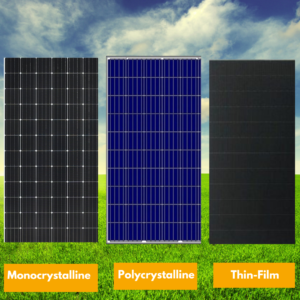TYPES OF SOLAR PANELS
THE MAJOR TYPES OF SOLAR PANELS
There are three major types of solar panels: monocrystalline, polycrystalline, and thin-film. Each type has its own unique advantages and disadvantages, and the solar panel type best suited for your installation will depend on factors specific to your own property and desired system characteristics.
 A monocrystalline solar panel is simply a solar panel made from monocrystalline solar cells or “wafers.” Monocrystalline wafers are made from a single silicon crystal that is formed into a cylindrical ingot. Although these panels are generally thought of as a premium solar product, the main advantages of monocrystalline panels are higher efficiencies and sleeker aesthetics.Because a monocrystalline cell is composed of a single crystal, the electrons that generate a flow of electricity have more room to move. As a result, monocrystalline solar cells are more efficient than their polycrystalline solar cell counterparts. You will need less monocrystalline panels for your roof to produce more kWh of electricity than other types of panels, but they are more expensive per panel.
A monocrystalline solar panel is simply a solar panel made from monocrystalline solar cells or “wafers.” Monocrystalline wafers are made from a single silicon crystal that is formed into a cylindrical ingot. Although these panels are generally thought of as a premium solar product, the main advantages of monocrystalline panels are higher efficiencies and sleeker aesthetics.Because a monocrystalline cell is composed of a single crystal, the electrons that generate a flow of electricity have more room to move. As a result, monocrystalline solar cells are more efficient than their polycrystalline solar cell counterparts. You will need less monocrystalline panels for your roof to produce more kWh of electricity than other types of panels, but they are more expensive per panel.
A Polycrystalline solar panels are also made from silicon. However, instead of using a single crystal of silicon, manufacturers melt many fragments of silicon together to form the wafers for the panel. Polycrystalline solar cells are also referred to as “multi-crystalline,” or many-crystal silicon.
Polycrystalline solar panels generally have lower efficiencies than monocrystalline cell options because there are many more crystals in each cell meaning less freedom for the electrons to move. Due to the easier manufacturer process, these panels have a lower price point on average. In addition, polycrystalline solar panels tend to have a blue hue instead of the black hue of monocrystalline solar panels. Because they are less efficient than other types of panels, you will need more to provide electricity for your home but their cost is lower.
A Thin-film solar panels, also called flexible solar panels, are made of one or more layers of thin-film material that absorb light and produce electricity. They are made using amorphous silicon thin film, cadmium telluride thin-film, gallium arsenide or copper indium gallium selenide. They’re fast and efficient to manufacture, which often makes them a more affordable solar energy option when compared to other solar technologies.
The thin, flexible, and lightweight photovoltaic cells that make up the panel are only around 1 micron thick (0.001 millimeters), which is only a fraction of the thickness of a penny.
https://news.energysage.com/monocrystalline-vs-polycrystalline-solar/


Leave a Reply